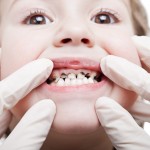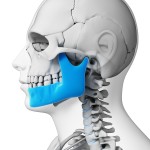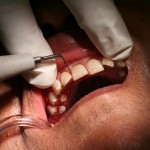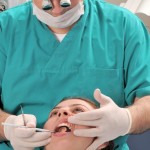Some evidence to support use of facemask appliance for class III malocclusions

Prominent lower front teeth (reverse bite; under bite; Class III malocclusion) are more common in oriental (15%) and black races (10%) and relatively uncommon in Caucasian (4%) populations. Several orthodontic approaches have been suggested to correct this and the aim of this Cochrane review was to assess the effects of orthodontic treatment for prominent lower [read the full story…]
Fluorescence-based caries detection methods need more work to establish diagnostic accuracy

Earlier this week (Dental Elf 15th Oct 2013) we looked at a systematic review that looked at a range of the newer aids for detecting caries. The aim of this review was to synthesize the findings about the accuracy of fluorescence-based methods in detecting caries lesions on occlusal, approximal and smooth surfaces of both permanent [read the full story…]
Limited evidence available for caries risk assessment systems

Predicting an individuals risk of caries is considered to be an important element in managing the condition and recommending appropriate care and treatment. A range of methods are currently used, included for example socio-demographic, socio economic, dietary factors, and oral hygiene practices. The aim of this review was to assess the accuracy and the quality [read the full story…]
Little evidence for the diagnostic accuracy of new caries detection aids

Caries is one of our commonest diseases and increasing emphasis is being placed on identifying its earliest stages in order to employ effective interventions. Visual examination and radiographs have been the traditional approaches to caries detection but newer adjunctive methods based on fiber-optics, fluorescence or electrical impedance have been developed and introduced during the past [read the full story…]
No evidence on whether antibiotic prophylaxis is effective or ineffective against bacterial endocarditis in people at risk who need invasive dental procedures

Bacteraemia is common following dental procedures and it was believed that this could lead to bacteria endocarditis a severe infection of the lining of the chambers of the heart with a high mortality rate. Until 2008 when National Institute for Health and Care Excellence (NICE) recommended that antibiotics were not required guidelines in many countries [read the full story…]
Temporomandibular joint replacement

Temporomandibular joint disorders (TMD) are normally managed conservatively however it has been estimated that aroung 5% require a surgical interventions (arthrocentesis, arthroscopy, condylotomy, and disc repair or removal (menisectomy). A small subset of patietsn may require Temporomandibular Joint (TMJ) replacement . Indications for replacement include:- bony ankylosis failed previous alloplastic and autogenous joint replacement post-traumatic [read the full story…]
Patients’ views of routine scale and polish over estimate any clinical benefits

Patients attending for their regular dental check up (usually 6-monthly) are likely to have a ‘scale and polish (oral prophylaxis) as part of that visit. However, a Cochrane review last updated in 2007 did not find evidence of sufficient quality to reach conclusions as to the benefits or harms or routine scaling and polishing. A [read the full story…]
Teaching toothbrushing with fluoride toothpaste – are we doing it well?

Toothbrushing at least twice a day with fluoride toothpaste is an effective way of reducing caries. This is confirmed by good systematic review evidence, so teaching patient effective toothbrushing with fluoride toothpaste is a key preventive strategy. The aim of this qualitative study was to explore oral health professionals (OHPs) perspectives regarding their strategies, considerations [read the full story…]
Evidence on the adverse effects of interproximal dental stripping is limited

Interproximal dental stripping or interproximal enamel reduction (IER) was originally suggested back in the 1940s as a method of gaining space in the lower incisor region. The aim of this review was to investigate the enamel roughness resulting from IER as well as the cariogenicity of IER in orthodontic patients. The databases, PubMed, Scopus, The [read the full story…]
Latest Cochrane Protocol

September has seen the publication of one new protocol from the Cochrane Oral Health Group. Sharif MO, Ahmed F, Worthington HV. Xylitol-containing products for preventing dental caries in children and adolescents (Protocol). Cochrane Database of Systematic Reviews 2013, Issue 9. Art. No.: CD010743. DOI: 10.1002/14651858.CD010743. The aim of the review is to assess the [read the full story…]
